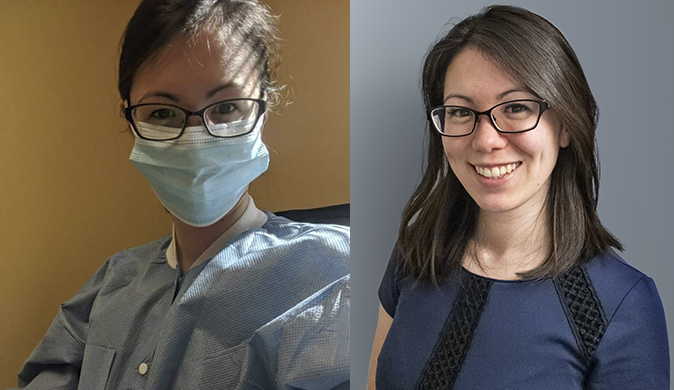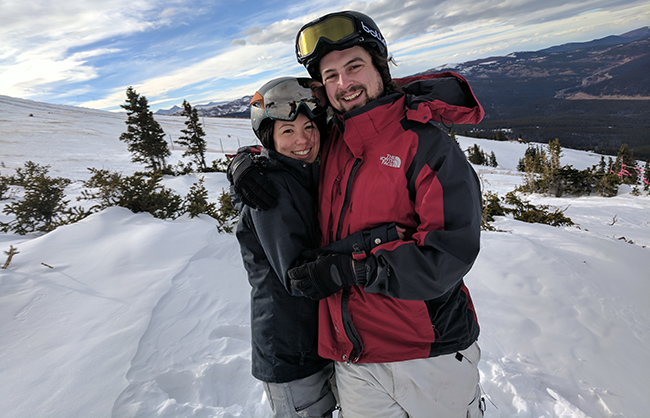One Patient Shares How PA Saved Her Life
Eating Disorder Leads to PA Care
August 21, 2022
By Jennifer Walker

Stephanie[1], who has an eating disorder, specifically purging type anorexia nervosa, credits Shion Harrison, PA-C, with saving her life. In 2016, Stephanie was drinking only water with lemon for three weeks, and she was walking six miles a day for months. Over the course of five months, she lost 70 pounds, as well as the majority of her hair, and would sometimes pass out on her walks. During that time, Harrison, her provider at Rose Internal Medicine and Diabetes in Denver, Colorado, responded quickly, either by getting her into the office for an appointment or sending her to the hospital or a treatment center for care. “If she hadn’t been there, I probably would have died,” says Stephanie, who has two children, ages 15 and 13. “I know for sure that I wouldn’t have been able to survive all of that.”
[Grow your network, find a mentor, and more – join or renew your membership today.]
Wanting to thank Harrison for this and so much more, Stephanie, now 41 years old, reached out to AAPA by email to ask if there was a way for Harrison to be recognized. “She has gone way above and beyond to learn how to best help me, check in on me, fight for me, and tell me that I’m important,” Stephanie wrote. “She is truly one of a kind and cares deeply about people.”
Harrison says she humbled that Stephanie would reach out to AAPA. “People don’t usually go out of their way to say, ‘This person made a big difference to me,’” she says. “That’s really touching.”
Becoming a Provider in Internal Medicine
While in the PA program at the Pennsylvania Institute of Technology in Williamsport, Pennsylvania, Harrison planned to practice in cardiology after graduation. But then she joined William Kubaska, MD, at Rose Internal Medicine and Diabetes, and her plans changed. “It turns out, I love internal medicine,” says Harrison, who became the practice’s second provider in 2015. “Looking at [my patients’] long-term well-being and getting to know them through the years and getting to know their family members and all about their lives has been incredible.”
At Rose Internal Medicine and Diabetes, Harrison gets a half hour to see patients for basic visits and an hour to see them for yearly physicals—lengths of time that she says make a big difference in the quality of care she is able to provide. For example, Harrison remembers one of her patients who would not get a colonoscopy. “In a 10-minute visit, you’re not really given enough time to talk to patients and [to] understand what their fears are,” she says. But Harrison had time to dig deeper, so she learned that the patient’s cousin had passed away from complications during a colonoscopy. Harrison was then able to talk with the patient to figure out a solution that worked for her.
Along with the generous appointment times at her practice, Harrison has had two influences in her life that have shaped who she is as a provider. The first came when a family member who is half-Japanese had a frustrating experience with the healthcare system. This family member was having a particular side effect to a medication that didn’t show up on the drug’s list of side effects. “[Her providers] didn’t believe her, and they wouldn’t take the time to talk or ask her how she felt,” Harrison says. It turned out some Japanese individuals metabolize this particular drug differently, which results in a slightly different side effect profile. Harrison’s family member eventually had a nurse practitioner who did some research, affirmed what she was feeling, and changed her medication.
[Has a PA impacted your life in a meaningful way? Share your story with AAPA.]
“That [experience] led me to really make sure that I’m communicating with my patients, and that everyone who walks through the door, regardless of background, feels comfortable with and understands what we’re talking about,” Harrison says.

Harrison has also been influenced by a short video from the Khan Academy called the “Ritual of the Bedside Exam.” She first saw the video as a student and didn’t think much of it at the time. But the content stuck with her, and she draws on it as a clinician today to build relationships with her patients.
In the video, Harrison says, they explained that people are coming to their medical providers in a vulnerable state and letting those providers touch them in ways that no one else does in the process of completing an exam. With this in mind, they then explained how providers could treat patients: Be gentle, put their hands on their patients’ backs, and make sure they’re really connecting with each person.
“This gave me insight and it’s completely 100% driven how I practice as a clinician,” Harrison says. “[My patients] are people just like me who are coming to me with their issues, and I’m so lucky, and I should do everything I can to make sure I deserve this honor.”
Harrison’s commitment to her patients shines through in Stephanie’s story.
Going Above and Beyond to Provide Care
In 2016, Stephanie was diagnosed with strep throat, which turned into scarlet fever, and she lost 13 pounds. “That set me on a cycle downward, and by the next time [Shion] saw me, I was doing very poorly,” says Stephanie, adding that this was the period when she lost 70 pounds. Harrison helped Stephanie get into the Eating Recovery Center in Denver, where she stayed for eight months.
Over the next three years, Harrison continued to support Stephanie by helping her fill out paperwork when she had to take medical leave from her job and coordinating care between Stephanie’s team, which, along with herself, includes a counselor and a nutritionist. She also helped Stephanie navigate two additional stays in inpatient treatment centers, as well as a diabetes diagnosis and hospital treatment for gastritis, and worked with her insurance company to try to get adequate coverage for the inpatient care.
Then, this past January, Stephanie again began having more intense symptoms that were associated with the eating disorder. “I didn’t want to go back to treatment because if it hadn’t worked the three times before, it wasn’t going to work now,” she says. “So Shion really did everything in her power to help me stay out of treatment.” In particular, Harrison called Stephanie daily to see how she was feeling and to discuss her symptoms.
“Touching base with her frequently kept her safe,” says Harrison, who also made it a priority to learn more about eating disorders by reading educational resources for clinicians and talking to specialists. (AAPA also provides a Nutrition Toolkit, which includes articles, podcast episodes, and more, as another resource.) “But also, I think it was important to let her know that someone cares a lot. She’s not just a walking set of diagnoses and numbers running around the world. She’s a human being that matters.”
[PA Inspires Patient to Follow in her Footsteps]
By April, Stephanie was in kidney failure, and Harrison told her that staying home wasn’t an option anymore. She had to go to inpatient treatment. Harrison found a good fit for Stephanie at a facility in Miami, where Stephanie stayed for two weeks before her insurance company cut off her coverage. Knowing that Stephanie needed more time at the facility, Harrison called her insurance company to get the criteria for residential care, wrote a long letter detailing how Stephanie met each of those criteria, and sent it to the Miami facility for them to use in talks with the insurance company. Stephanie was able to return to residential care for four weeks.
But this experience with insurance coverage is one that Stephanie has had more than once in trying to get inpatient treatment. “Eating disorders are treated as this acute physical state,” Harrison says. “If your kidneys are failing or your heart is having some kind of issue, then we’ve got to get you into a treatment center. But once you’re physically stabilized, they no longer approve extensions in the stay. So they don’t actually treat the underlying reason that the person is there in the first place.” This is a major reason that Harrison has become such an advocate for Stephanie to receive quality care.
Since her time at the Miami facility, Stephanie has received virtual care and attended another inpatient treatment facility in Arizona, where she had the same experience of her insurance coverage running out early. After 10 days, Stephanie had to come home, where she stayed for two months. Then, in early October, Stephanie entered a treatment center in Seattle. Harrison will coordinate with the team at the treatment center while she’s there and continue to provide care to her once she returns home.
“[Shion] often tells me she cares about me and that I’m important as a person and not just as a patient,” Stephanie says. “There have been times when I felt like I’m not worth it anymore and she’s helped me get the care and the help that I needed. And I’m just so thankful for it.”
Harrison says that Stephanie has always been caring and thoughtful and the fact that she took the time to get in touch with AAPA says a lot about her as a person. “But I wish I could shine the light on everyone,” adds Harrison, who enjoys making fermented foods and listening to audio books in her spare time. “There are all kinds of healthcare providers out there who make a big difference.”
Jennifer Walker is a freelance writer in Baltimore, MD. Contact Jennifer at [email protected].
Originally published October 2020.
You May Also Like
PA in Orthopaedics Saves Patient’s Life with Generalist Education
PA Donates Kidney to 2-Year-Old Boy with a Rare Disorder
Right Time, Right Place: PA Saves a Life
The Power of Empathy in Healthcare
[1] Stephanie asked to be referred to by only her first name for this story.
Thank you for reading AAPA’s News Central
You have 2 articles left this month. Create a free account to read more stories, or become a member for more access to exclusive benefits! Already have an account? Log in.



